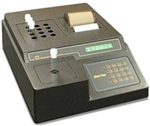Description
Faster Throughput
- Increased throughput up to 240 samples/hour depending on the tests assayed.
- Faster cycle time for inventories, pipetting and fluid handling.
Minimal Changes
- No changes to spare parts/consumables for the end user.
- Maintenance schedules are almost identical. Waste tubing maintenance schedule reduced from 6 to 4 months.
- Limited changes to existing reagents. BUN, GGT and ALP parameters have been slightly modified to improve performance on all models.
- Minimal hardware changes. No additional service training required.
Easy Tracking & Transition
- Track different analyzer versions by serial number: Higher speed analyzers have an 11-digit serial number versus 8-digits for the current versions.
- No changes to analyzer catalog (REF) numbers. REF 10405 (with ISE & Printer)
Benefits of moderately complex drug screening on the EasyRA analyzer
- Fully automated enhancing efficiency
- Positive/negative results reported, no manual visual interpretations
- Reduce risk of transcription errors with automated data entry and bidirectional LIS communication
- Give clinicians more control by allowing them to run individual analytes of interest
- Single platform for drugs of abuse in urine and routine chemistries
Features:
- Waste tubing maintenance schedule reduced from 6 to 4 months
- Limited changes to existing reagents. BUN, GGT and ALP parameters have been slightly modified to improve performance.
- Minimal hardware changes and no additional service training required
- Sample cups or primary tubes in a wide range of sizes
- Data storage of 2000 patient results; 56,000 test results, ability to archive and retrieve results
Medica EasyRA analyzer Includes Installation, Training, Validation, and One Year Manufacturer Warranty.
Technical Specifications:
- System specifications: True random access, clinical chemistry analyzer
- Throughput: Patient results per hour, photometric: up to 240 tests/hour*; ISE: up to 240 tests/hour*; STAT time: 8 minutes (Na+/K+/Cl-/CO2/GLU/BUN/CREA)
- Types of analysis: Endpoint, enzymatic, rate, biochromatic, potentiometric, enzyme immunoassay (EIA), turbidimetric immunoassay (TIA)
- Samples: 24 sample positions per sample ring for patient, calibrator, or QC samples; STAT: up to 5 user-defined positions; optional second sample ring uniquely identified by analyzer; automatic dilution: 1:2, 1:3, 1:5 and 1:10 final dilution
- Sample volume: Photometric chemistries: 2.0–25.0 μL; programmed in 0.1 μL steps; ISE chemistries: serum: 80–90 μL; urine: 140 μL
- Sample containers: Sample cups or primary tubes in a wide range of sizes
- Sample identification: Position ID, barcode ID (optional), barcode types: codabar, code 39, 128, interleaved 2 of 5
- Reagents: 24 positions for reagents; reagent cooling temperature 12º–15º C less than ambient; reagent identification: RFID (radio frequency identification) technology – automatic tracking and entry of reagent information (chemistry name, lot number, expiration date; reagent volumes; analysis volumes for reagents, samples, diluent; primary and secondary wavelengths; reaction read times; analysis type; reagent and sample blanking; linear range of assay; acceptable absorbance ranges). Reagents are ready to use. 6 open channels.
- Reagent volumes: Reagent volume (R1)/test 120–350 μL; programmed in 1 μL steps. reagent volume (R2)/test 10–50 μL; programmed in 1 μL steps
- Water supply: Reagent grade deionized water, diluent bottle
- Sampling system: Probe pre-heater; single probe with RF level sensing; inner and outer probe washing
- Cuvette material: Optical acrylic; disposable segments; 12 cuvettes per segment; 6 total segments in reaction area
- Reaction time: 1–15 minutes
- Reaction temperature: 37º ± 0.25º C (photometric chemistries)
- Wavelength: 340, 405, 520, 550, 600, 660, 700; half bandwidth 10 ± 2 nm
- Light source: xenon flash lamp, 5 year typical life
- Photometric linearity: 0.0–2.5 Abs units for 0.6 cm pathlength (1% deviation)
- Photometric resolution: 0.0001 Abs units at 1.0 Abs
- Quality control: 2 levels of controls (Levey-Jennings plots for two levels)
- Calibration curves: Single and multilevel calibration (based on analyte)
- User interface: Edit and monitor worklists; review results; review calibration and quality control results; Levey-Jennings charts for 31 days of QC results; on-board diagnostics and individual component monitoring; graphic instructions for daily, weekly and monthly maintenance procedures
- Power requirements: 100 VAC–240 VAC ± 10% 50–60 Hz, 4.0/2.0A
- Size and weight: 40˝ w x 15˝ h x 26˝ d (102 cm x 38 cm x 66 cm), 88 lbs (40 kgs) without reagents
- Ambient conditions: 15º–30º C (59º–86º F); <85% relative humidity, non-condensing atmospheric air environment
- Computer requirements (minimum): Windows® 8**; CD/CD-RW; 1 RS-232 or USB port; touch screen monitor or SVGA color monitor, mouse and keyboard
- Optional features: ISE Module





Reviews
There are no reviews yet.